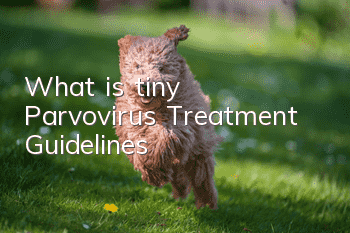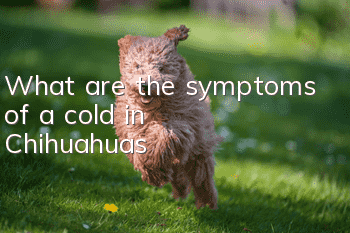What is tiny? Parvovirus Treatment Guidelines

Canine parvovirus, also known as canine infectious hemorrhagic enteritis, is an acute infectious disease in dogs caused by canine parvovirus. It mainly affects dogs of all ages, with puppies aged 2 to 6 months being the most susceptible. , the incidence rate is also the highest. The short course is 4 to 5 days, and the long course is more than 7 days. The clinical cure rate is low. Dogs of different breeds, ages, and genders can be infected by the disease. The main clinical symptoms are myocarditis type in young dogs, enteritis type in adult dogs, and some dogs show mixed type.
1. Epidemiology
The causative agent of this disease is canine parvovirus of the genus Parvovirus in the family Parvoviridae. Seasonal disease often occurs in Wuxi area, and the incidence rate is high in summer and autumn. The disease can be transmitted through direct or indirect contact, mainly through the digestive tract. When a sick dog comes into contact with a healthy dog or a healthy dog comes into contact with the feces and urine of a sick dog in the grass. All will be infected with this virus. Among them, the feces of sick dogs contain the highest level of poison. Asymptomatic carrier dogs and recovering dogs can be carriers for a long time.
2. Clinical symptoms
1. Enteritis type
Most appear in puppies and adult dogs aged 2-6 months. The incubation period is 1-2 weeks. They usually vomit first and then have diarrhea. Diarrhea is dilute and watery. The color is yellow or grayish yellow at first. Some of them contain large amounts of mucus. Some of them have pseudomembranes. Then their poop is like tomato juice. They have a special smell. The sick dog was depressed, refused to eat, and had a body temperature that rose to over 40 degrees. Blood tests showed that the total number of white blood cells decreased, the body temperature of the late-stage sick dog dropped below normal temperature, it was difficult to breathe, and the dog died of acute fatigue. The course of the disease is as short as 5 days and as long as 1 week. Adult dogs generally do not have elevated temperatures in the clinic. The main cause is severe physical exhaustion and dehydration due to diarrhea and vomiting. Some dogs have secondary symptoms such as intussusception (poor prognosis).
2. Myocarditis type
This type has a low incidence and is rare clinically. It mainly occurs in the early stages of CPV disease outbreaks and in unvaccinated puppies under 2 months of age. It often occurs suddenly and manifests as groaning, muscle tremors, coldness at the end of the limbs, ears and nose, cyanosis of visible mucous membranes, difficulty breathing, dry cough, elevated body temperature, irregular heartbeat, and murmurs. It is more common in the early stages of the epidemic. Often mixed with enteritis type. Most patients die suddenly during treatment due to heart failure, with the mortality rate as high as 80% and the duration of the disease generally not exceeding 24 hours.
3. Specific cases
1. Animal disease conditions
On March 12, 2016, our hospital admitted a Bichon Frize, 1 year old, weighing about 3 kg. The owner reported that the dog became lethargic and unwilling to move 3 days ago, vomited yellow-white frothy liquid, lost appetite, and had an increased frequency of loose stools. The dog's clinical symptoms were: poor energy, sunken eye sockets, reduced skin elasticity, loose anus, defecation incontinence, and feces that looked like ketchup and had a foul odor. The rectal temperature was 39.8°C.
2. Diagnosis
Epidemiological investigation and clinical symptom analysis revealed a preliminary diagnosis of canine parvovirus disease. Canine parvovirus diagnostic test strips produced in South Korea are used for detection. The specific operation method is: use a cotton swab to collect the feces of sick dogs, soak it in a sampling tube containing reaction buffer, and mix thoroughly. Place the test plate flat on a well-lit, dry, clean table. Use a dropper to slowly and accurately add 4 drops of the mixture into the sample well. After 5 minutes, a purple-red line appeared in the test area T and control area C respectively, indicating that the bear dog was infected with canine parvovirus.
3. Treatment
Specific therapy is adopted, combined with symptomatic treatment, replenishing water, adjusting electrolytes, acid-base balance, appropriate supplementation of energy and nutrients, etc. The specific treatment measures are as follows.
(1)Specific therapy. 4 million IU of canine recombinant interferon α mutant was injected subcutaneously, and 5 mL of canine parvovirus monoclonal antibody was injected intramuscularly for 5 days, once a day.
(2) Symptomatic treatment. Use ceftriaxone sodium 0.4g, intravenous injection of 100 ml 5% glucose, once a day; ATP 5 mg, coenzyme A 50 iu, inosine 20 iu, vitamin C 1 ml, vb61 ml, 50% glucose 10 ml, intravenous injection 5 % glucose, once a day; subcutaneous injection of 2 ml of phenoethylamine, subcutaneous injection of metoclopramide 1 ml, once a day. one day.
IV. Results
On the first day of treatment, the condition was fair, and the visible yellowing symptoms of mucous membranes and skin basically disappeared; on the second day, the diarrhea stopped, the frequency of vomiting decreased, the body temperature was 38.9 ℃, and the rhinoscope Sweating and mental improvement; on the third day, the diarrhea and vomiting basically stopped, the body temperature was normal, there was a slight appetite, and the feces was black; on the fourth day, the dog's body temperature was 38.6°C, the spirit was normal, the appetite was restored, the eyes were bright, the feces and urine were Fluids were normal. On the fifth day, the patient was discharged after continuing treatment with the same method.
5. Summary and discussion
Canine parvovirus disease is an acute and severe infectious disease in dogs caused by canine parvovirus infection. The hemorrhagic enteritis type is more common, accounting for approximately 10% of canine parvovirus infections. 80% of cases. There are currently many commonly used serological diagnostic methods for canine parvovirus disease, but the recently introduced canine parvovirus enzyme-labeled diagnostic kit is simple and easy to use. After a dog is infected with CPV, as long as it does not cause acute death, a certain titer of anti-CPV antibodies can be produced in 5 to 7 days. Therefore, specific therapy, control of secondary infections, symptomatic treatment, replenishing water, and adjusting electrolytes and acid-base balance are adopted. Appropriate supplementation of energy and nutrients, timely correction of water and electrolyte imbalances, and prevention and treatment of secondary infections are expected to make the disease recover. The key to the treatment of this disease is early diagnosis and early treatment. Clinically, recombinant canine interferon alpha mutants and canine parvovirus monoclonal antibodies are used to treat CPV in the early stage of the disease, which is more effective, but the cost is higher. Hemostatic therapy can prevent anemia and fight shockThe effect is beneficial to the recovery of sick dogs. Enema therapy can also be used during the treatment of this disease, which can effectively remove putrefactive contents in the intestines and prevent autotoxicity. It can also reduce inflammation, stop diarrhea, and nourish the body. The disease comes on quickly, is critical, and is difficult to treat. We should focus on vaccine prevention, strengthen feeding and management, and conduct regular deworming to ensure the health of dogs. While preventing this disease, regular disinfection of kennels should be done, and special attention should be paid to dog care in winter and spring. The feces, vomit, saliva of sick dogs and the feces and urine of recovered dogs are important sources of infection. Healthy dogs can become infected through direct contact with sick dogs or eating contaminated feed and drinking water. In the actual production process, pet dogs have more opportunities to come into contact with sick dogs when they go to the veterinary clinic for vaccination. Animal owners and clinic directors should pay more attention.
- The dog suddenly becomes weak in its hind legs and walks unsteadily
- What does it mean when a dog opens his mouth?
- Gray Teddy's hair follicles are damaged and turn into black hair
- Can Teddy eat grapes?
- How many months does it take for a dog to have a baby?
- There is something like a blood scab on the dog’s head
- What's wrong with the dog that keeps barking when he won't sleep?
- How many times do dogs need to be walked a day? Science can help you analyze it!
- Do dogs need to be covered with quilts when sleeping at night? It depends!
- 4 ways to treat fleas on dogs



